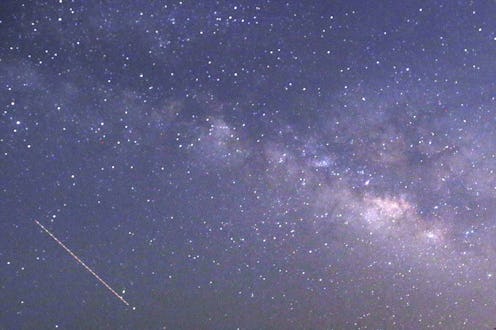Life
This Is The Coolest Planet You Didn't Learn About In Science Class

Former (and current) goth kids, prepare to meet your spiritual home. On Thursday, astronomers announced that, much like your cold, cynical heart, the newly-discovered exoplanet WASP-12b is pitch-black, reflecting almost no light from its atmosphere. It's also immense, mind-blowingly hot, and being devoured by its parent star at this very instant. Maybe if high schools had taught this kind of stuff in science class, fewer students would have snoozed their way through physics. I'm just saying.
Since WASP-12b was discovered in 2008, it has become one of the most well-studied exoplanets — that's the fancy astronomical term for any world orbiting outside our particular solar system — in the Milky Way. Recently, astronomers at Canada's McGill University and the University of Exeter in the UK used the Hubble Space Telescope to calculate how much light the exoplanet reflects. Like the moon, most planets can't produce their own light; they can only reflect it. (That's why they appear so tiny in the night sky, despite being relatively close to Earth.) This information, known as its "albedo," can help researchers better understand a planet's atmosphere.
But when researchers measured WASP-12b's albedo during an eclipse last October, the results took an unexpected turn. According to their calculations, the exoplanet is two times less reflective than our moon and doesn't appear to reflect light on any wavelength. In a press release, lead author Taylor Bell called the albedo value "extremely low," describing the exoplanet as "darker than fresh asphalt." Basically, you would need the eyes of an actual Tolkien elf to spot WASP-12b in the night sky.
But wait — there's more! WASP-12b is pretty much what would happen if Jupiter never outgrew its death metal phase and still wore tripp pants. The exoplanet is also a gas giant, meaning it's largely composed of gases with a small, rocky core. Of all the planets in the Milky Way discovered to date, it's one of the hottest. According to NASA, its surface is nearly 2,800 degrees Fahrenheit, so hot that clouds are unable to form. While it doesn't reflect light, researchers found that it's so hot that it actually emits a tiny bit of glowing light of its own.
This is all because WASP-12b is a close neighbor to the sunlike star it orbits — too close for its own good. In 2010, astronomers discovered that the exoplanet is being consumed by its parent. It's been drawn so near that WASP-12b takes just 1.1 Earth days to complete an orbit, and the star's gravitational forces have stretched it into a football-like shape, rapidly expanding its atmosphere at the same time. (Right now, its radius is three times the size of Jupiter's.) All the while, the exoplanet is gushing material onto the star.
As you can imagine, this doesn't bode well for the exoplanet's lifespan. Astronomers have given WASP-12b just 10 million more years left to live. While it's going to outlive you and me, barring some miracle of science, that's actually a brief moment in the lifespan of a planet. Earth is 4.54 billion years old, and our sun is 4.6 billion. The oldest known stars in the Milky Way are thought to have existed for 13.4 billion years. In the grand scheme of things, WASP-12b's death isn't all that far off. On a totally random note, has anyone else been struck by the realization that humans are naught but specks of dust floating through an incomprehensibly ancient universe?
Moving on.
To recap, WASP-12b is a gigantic, pitch-black, superheated gas giant doomed to a particularly nasty end: being eaten by its parent star. That's the kind of material future generations deserve to learn. Who knew astronomy could be so dramatic?